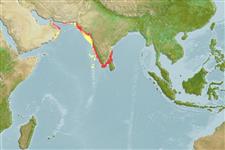分类 / Names
俗名 | 同种异名 | Catalog of Fishes(属, 种) | ITIS | CoL | WoRMS | Cloffa
Teleostei >
Clupeiformes (Herrings) >
Dorosomatidae (Gizzard shads and sardinellas)
Etymology: Sardinella: Latin and Greek, sarda = sardine; name related to the island of Sardinia; diminutive (Ref. 45335).
More on author: Valenciennes.
Environment: milieu / climate zone / depth range / distribution range
生态学
海洋; 海洋洄游的 (Ref. 51243); 深度上下限 20 - 200 m (Ref. 28016). 熱帶; 25°N - 7°N, 57°E - 81°E (Ref. 54872)
Indian Ocean: northern and western parts only, Gulf of Aden, Gulf of Oman, but apparently not Red Sea or the Persian Gulf, eastward to southern part of India, on eastern coast to Andhra; possibly to the Andaman Islands. Thus, studies pertaining to this species from the Philippines or Indonesia probably refer to Sardinella lemuru.
印度洋: 北部與西部只有, 亞丁灣,阿曼灣, 但是顯然地不紅海或波斯灣, 向東至印度南部, 在東岸上對安得拉省; 可能地到安達曼群島。 因此,可能屬於這種從菲律賓或印尼的研究指的是 沙丁魚 lemuru 。
Length at first maturity / 大小 / 重量 / 年龄
Maturity: Lm 16.3 range ? - ? cm
Max length : 23.0 cm SL 雄鱼/尚未辨别雌雄; (Ref. 188); common length : 20.0 cm SL 雄鱼/尚未辨别雌雄; (Ref. 188); 最大体重: 200.00 g (Ref. 4883); 最大年龄: 3 年 (Ref. 3689)
背棘 (总数) : 0; 背的软条 (总数) : 13 - 21; 臀棘: 0; 臀鳍软条: 12 - 23; 脊椎骨: 45 - 49. Body sub-cylindrical; a faint golden spot behind gill opening, followed by a faint golden mid-lateral line; a distinct black spot at hind border of gill cover (absence of pigment). Distinguished from all clupeids in the northern Indian Ocean by its pelvic fin ray count of i 8; from S. neglecta and S. lemuru by its longer head and more lower gill rakers. No prominent keel. See also Refs. 3683, 818 and 393 .
身体接近圆柱形的; 一个模糊的金斑点在后鳃裂,跟随着一条模糊的金侧面中央的线了; 在鳃盖的后部边缘的一个明显的黑色斑点.(缺乏有颜色) 用它的 i 8 的腹鳍鳍条计数在印度洋北部中与所有的鲱鱼区分了; 从 S. neglecta 与 S. lemuru 用它的较长的头部与更多的下鳃耙。 没有突出的龙骨脊。 也见参考文献。 3683,818 与 393.
Coastal pelagic (Ref. 68964). Forms schools in coastal waters and strongly migratory. Feeds mainly on phytoplankton (especially diatoms) and small crustaceans (Ref. 30573). Breeds once a year off western coasts of India when temperatures and salinity are low during the southwest monsoon months. Spawning peaks in August-September. Occurs at temperatures of 22.0-28.0 °C (Ref. 3689). Marketed fresh, dried and dried-salted. Also sold smoked and canned (Ref. 9987). Also made into fish meal and fish balls.
在沿岸水域中形成鱼群与强烈的回游性。 主要吃浮游植物 (尤其硅藻) 与小型甲壳动物。 (参考文献 30573) 当温度与盐度在西南的季风数个月期间是低的时候,每年一次繁殖印度的外海西海岸。 在八月到九月产卵峰巅。 生存在 22.0-28.0 °C 的温度。 (参考文献 3689) 在市场上销售生鲜地, 乾制了与乾燥盐腌。 也卖烟熏而且装于罐头。 (参考文献 9987) 也制成鱼粉与鱼丸。
Life cycle and mating behavior
成熟度 | 繁殖 | 产卵场 | 卵 | 孕卵数 | 仔鱼
Spawning usually takes place at night (Ref. 810). 印度洋: 北部與西部只有, 亞丁灣,阿曼灣, 但是顯然地不紅海或波斯灣, 向東至印度南部, 在東岸上對安得拉省; 可能地到安達曼群島。 因此,可能屬於這種從菲律賓或印尼的研究指的是 沙丁魚 lemuru 。
Whitehead, P.J.P., 1985. FAO Species Catalogue. Vol. 7. Clupeoid fishes of the world (suborder Clupeoidei). An annotated and illustrated catalogue of the herrings, sardines, pilchards, sprats, shads, anchovies and wolf-herrings. FAO Fish. Synop. 125(7/1):1-303. Rome: FAO. (Ref. 188)
世界自然保护联盟红皮书 (Ref. 130435: Version 2024-2)
人类利用
渔业: 高经济性
工具
特别资料
下载 XML
网络资源
Estimates based on models
Preferred temperature (Ref.
123201): 22.1 - 26.7, mean 24.7 °C (based on 63 cells).
Phylogenetic diversity index (Ref.
82804): PD
50 = 0.5000 [Uniqueness, from 0.5 = low to 2.0 = high].
Bayesian length-weight: a=0.00692 (0.00590 - 0.00811), b=3.03 (3.00 - 3.06), in cm total length, based on LWR estimates for this species (Ref.
93245).
营养阶层 (Ref.
69278): 2.4 ±0.22 se; based on food items.
Generation time: 1.2 (1.1 - 2.0) years. Estimated as median ln(3)/K based on 19
growth studies.
回复力 (Ref.
120179): 中等的, 族群倍增时间最少 1.4 - 4.4年 (K=0.5-1.4; tm=2; tmax=3; Fec=19,028).
Prior r = 0.46, 95% CL = 0.31 - 0.69, Based on 1 full stock assessment.
Fishing Vulnerability (Ref.
59153): Low vulnerability (17 of 100).
Climate Vulnerability (Ref.
125649): Moderate to high vulnerability (53 of 100).
Nutrients (Ref.
124155): Calcium = 243 [124, 369] mg/100g; Iron = 1.94 [1.13, 3.42] mg/100g; Protein = 20.2 [19.2, 21.2] %; Omega3 = 0.302 [0.145, 0.589] g/100g; Selenium = 130 [68, 257] μg/100g; VitaminA = 22.9 [6.9, 69.7] μg/100g; Zinc = 1.3 [0.9, 1.8] mg/100g (wet weight); based on
nutrient studies.
